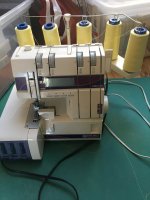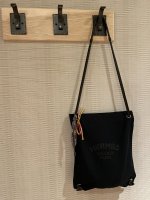Yes Eagle I have portable domestic
serger.
Theoretically I like it but almost never use it. You go through a lot of thread & if you use various different fabrics you have to recalibrate the tension controls to a suitable setting for your current fabric.
I suggest you get a proper orientation sessions included with your purchase, I didn't as covide was just starting & the last thing I wanted to do was get close to a stranger whose job was being close w/ other strangers.
I know you are meticulous & patient so you should be just fine. Anticipate you might use a fair bit more fabric for your project. I used commercial heavy duty Sergers at art college & in the garment industry & those were much easier to to navigate.
However go to a very reputable domestic sewing machine or make sure you can return the sergers if it does not suit your needs when you start working with it.
I got a Viking and always understood it was a reliable company.
The industrial sergers were entirely different.
I prefer other ways to finish seams depending on the thickness of the fabric & tricky curves.
Let me know if you have any concerns not addressed.
Happy to help anytime
Thank you, CC. I found it interesting that you might choose to clean-finish seams by other methods. I like neat finished seams most of the time. In the early 90s I made an apple green wool gab button front calf length skirt. I kept an apple green knitted pullover which would probably fit under a nicely made a.g. Talbot's blazer. (I lost weight between now and then). And I have a not-too-casual tee shirt from that time. The greens all go together!
H made an Early America scarf in an a.g. that matches the skirt. It's really quite something that the manufacturers used very similar dye lots at that time, they were all on the same page. Because I don't think I'll get much matching or coordinating stuff to the same apple green these days. Contemporary, (as of 2022) apple green is more of a lime than a Granny Apple. (I do have a ton of various shades of lime fabric, it's the new "yellow" these days. But when bright yellow came in around 2019 I made the same skirt again. I like buying buttons and fussing over what is exactly the best match or interesting combo. The store doesn't care, the buttons are loose in boxes keyed to various colors. Did you ever go to Tender Buttons in NYC? Fabulous store with wall to wall button boxes of loose buttons. Closed when zip front suit-style jackets came in. However, I have a good button stash by now.
I have always been a bit intimidated by sergers. I'm aware of the need to take a class. I have lost some depth perception in my vision and I have a hard time threading the sewing machine needle. I don't know if serger needles are as difficult to thread as the machine. (I do have some easy threading needs which I haven't tried yet). I also am not particularly fond of machines that I have to learn how to use b/c they have so many bells and whistles.
So I purchase color-coordinated seam binding and use that to finish the seams. I could use a Hong Kong finish but that would not be worth the work of cutting bias strips for a spectacular garment interior. Using commercial binding adds a bit of work to the finishing process but threading and learning to use a serger has got to be time consuming!
I use a Sears Kenmore sewing machine that I bought in 1971. It's pretty basic as you can imagine. Stretch stitching, a buttonhole template, some choice in stitches and that's it. I actually bought a duplicate machine, same model, on ebay, figuring that the machine I already had would conk out eventually. In fact the motor died on the original with a loud long wail like an animal was dying. Never heard that before! I had a tech look over the substitute machine and for $100 the machine turned out to be a good purchase.
There's supposed to be an easy to use beginner serger in the market. It might be Janome. I used to have tremendous trouble maintaining a decent thread tension, tweeking and tweeking, but now, not so much. At that time, (early 90's) Viking was supposed to have easy to adjust tension). I think the machine set the tension according to the weight of the fabric.
I appreciate your comment that sergers use a lot of thread. Sewing at home does contribute to accumulation of various supply, of course, chief among them, fabric. A robot that does the pattern layout and cutting would be a really good contribution to home sewing. This could probably revive the whole industry. During the 80's with "dress for success" in the air, there was wonderful fabric selections. Really interesting stuff from Europe. I'm guessing home sewing is not as viable anymore perhaps because clothes are fairly inexpensive these days. Sewing gives me the option of copying outfits, getting unique outfits, or matching RTW garments.






